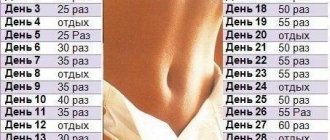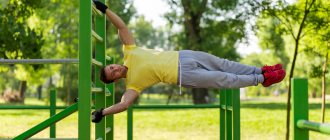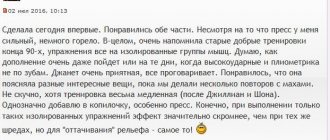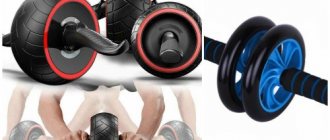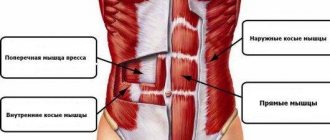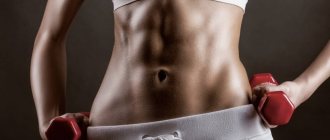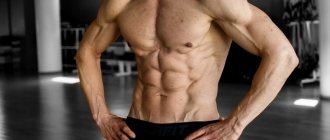Every person undoubtedly wants to look beautiful and attractive and, of course, be in good physical shape, but many people remember that they need to tone their body only before certain events, for example, a vacation or some important event.
That is why many people are concerned with the question of how to quickly get the desired result, including how to pump up your abs in a week. The last question very often worries girls.
Therefore, in this article we will tell you about the possibilities of obtaining this result.
Every person understands that considerable effort must be made to achieve results. The same applies to abdominal workouts.
It is impossible to get perfect abs in a week, but a couple of weeks will be enough to get relief in the abdominal area.
To obtain maximum results, of course, regular training in the gym is necessary, but if it is not possible to regularly visit the gym, then you can do training at home.
There are a lot of exercises for training that can be performed at home without the use of special equipment.
Abdominal Anatomy
Illustration from Wikipedia
The rectus abdominis muscle consists of two parallel muscles. This is a paired, flat, long, ribbon-shaped muscle, wide at the top and narrowed at the bottom, located on the side of the midline.
Both rectus muscles are separated from each other by the linea alba. It begins on the pubic crest and pubic symphysis, goes upward and attaches to the anterior surface of the xiphoid process and to the outer surface of the cartilages of the V-VII ribs.
The muscle bundles of the rectus abdominis muscle are interrupted by 3-4 horizontal tendon bridges.
Thus, the popular question “how many abs does a person have?” you can answer that eight (although the two lowest ones are always a little less noticeable).
Biomechanics of the abdominal press
The abdominal muscles work when lifting the pelvis with a fixed chest, flexing the spine, lowering the ribs. They also pull the chest down while the spine and pelvic girdle are fixed.
The rectus muscle, as mentioned above, acts as the main stabilizer of our body in the vertical plane. Thus, these muscles work almost always.
We’re done with the dry theory, now it’s time to talk about different abdominal exercises.
Here is a complete exercise program for abs, information on how much you need to pump up your abs, as well as nutrition.
I would like to make a reservation right away:
This article will not include exercises for the oblique muscles, as they can increase your waist size.
Again, as mentioned above, if you want a narrow waist and visually prominent abs, be sure to follow a diet.
Abs in a week at home
To achieve results in pumping your abdominal muscles, you must follow a training schedule and training program.
Naturally, training alone will not be enough to achieve results. It is important to follow the recommendations of nutritionists and strictly adhere to them, otherwise all your efforts in the form of physical activity will be unnoticeable.
Basic recommendations from nutritionists:
First of all, it is necessary to exclude all harmful foods from the diet, including fatty and fried foods.
It is also very important to minimize the consumption of salt, which retains excess water in the body.
Sugar and all sweets should also be kept to a minimum.
Main meals should be divided into several small meals and distributed so that the interval between meals is 3-4 hours.
In order to speed up metabolism, you need to increase the amount of liquids consumed per day to at least 1.5 liters. Thanks to this, everything unnecessary will begin to leave your body and this will help you quickly see the desired abs on your stomach.
Of course, proper nutrition will not be enough, but this will be the first step in achieving quick results in the appearance of six-pack abs in a week.
Getting abs in 1 week is not an easy task, and it is impossible to achieve the appearance of cubes in such a short period of time.
But for the abs to begin to appear, a week will be enough. During this time, your abdominal muscles will become toned and you will want to continue to strive for results.
By the way, the classic exercise for the abdominal muscles not only allows you to get six-pack abdominal muscles, but also helps strengthen your back muscles, which is also important in the everyday life of every person.
Abdominal exercises
Hanging leg raises on the bar
Without a doubt, this exercise can be objectively called the best among all known.
Firstly
, in addition to the abs, you are working in the hip joint, which means that the load on the rectus abdominis muscle is maximum.
Secondly
, we do not have support in the back, which means that there is no load on the lower back at all, which is very useful for those who have protrusions or hernias of the lumbosacral spine. Moreover, this exercise is an excellent prevention of back problems.
Technique:
grip shoulder-width apart or slightly wider, stretch out completely on the bar, while inhaling, raise your legs to the horizon (advanced people can throw their socks up to the bar, lightly touching it), while exhaling, SMOOTHLY lower your legs down to the starting position.
The key point is in the negative phase (during lowering the legs), since it is at this moment that the rectus muscle stabilizes our body as much as possible, which means it works to its fullest.
Pump your abs carefully, take your time with movements, contract and stretch your muscles. If it is difficult to lift your extended legs, bend them at the knees, but try to occasionally add repetitions with your limbs fully extended.
Classic crunches
Here I would like to consider several options at once:
- the twists are correct;
- the twists are incorrect (most often this is the option that occurs);
- twisting with a pancake in hands (complicated version).
— The twists are correct
Perhaps the most accessible exercise among all those available for the press. You can perform it anywhere: at home, in the gym and even on the street.
Technique:
lie on the floor, bend your knees, place your hands at your temples or in front of you. Holding your hands behind your neck, on the back of your head is wrong. Twisting in this position, we begin to twist our neck forward, this is fraught with injury to the cervical vertebrae.
As you inhale, move FORWARD, twisting your body, and as you exhale, return to the starting position. The body needs to be twisted, not pulled upward. In the next paragraph we will tell you about the wrong option.
— Twists are incorrect
Pay attention to the position of the hands - they are behind the head, and this is the first mistake.
Secondly, pay attention to the manner of execution - the body is not twisted, but moved upward. Yes, at the initial stage of movement of the abdominal muscles you will feel, but as soon as you go through an angle of 45 degrees, the lumbosacral region will take on the entire load, and this is already dangerous.
In my coaching practice, there was a person who earned a protrusion in his lower back with this exercise, so it’s better to forget about this exercise technique forever.
Yes, amateurs can convince you that this is also correct, but it’s not true, don’t give in! At the martial arts section, they also tried to prove to me that this was an authentic manner of performing the exercise, but everyone had back pain (which was justified by the heavy load). I retrained everyone, and their backs stopped hurting. Miracle, no less!
— Pancake crunches (complicated version)
Has it become too easy? Are you already doing about a hundred repetitions? Try to complicate the exercise - pick up a pancake and pump up your abs to the fullest!
Technically and in terms of breathing, everything is similar to the classics, only this time the arms are extended perpendicularly upward and hold the pancake. Twist your body, trying not to tilt the pancake parallel to the movement, always keep it perpendicular, slightly reduce the amplitude in the exercise, and you are guaranteed a new type of load in terms of force!
Book
Also a very simple exercise in the context of inventory. You may just need a rug, but you can do without it. Technically, the “book” is a little more complicated than twisting, so be patient - it may not work right away.
Technique:
position yourself on the floor, stretch out completely (here you don’t need to bend your knees in the starting position), while inhaling, move your body and legs towards each other, as if folding, and straighten up as you exhale. Got it, why a book?
Perform about 20-30 such manipulations, and you will hardly want to finish reading it, this book is too overwhelming. Or not?
Slide twists
The technique is something between crunches and a book:
We lie on the floor, legs bent at the knee joint. As you inhale, twist your body, at the same time raise your legs up and stretch your arms towards your toes.
As you exhale, return to the starting position. Technically it is not the simplest, so skill is required.
Scissors
A very simple exercise, but make no mistake about it - it loads the abdominal muscles as they should!
Technique:
stretched out on the floor, lightly resting our hands on the surface, we begin to work with our legs as if we were cutting the air like a sheet of paper. Let's breathe freely.
The exercise, by the way, is perfect for those who have hernias and protrusions in the lumbosacral region. Leg work creates work in the hip joint, unloading it and thereby improving blood flow.
I often give this exercise to my guys with similar problems at the beginning and end of training. So take note.
Plank
“Seriously, does this need any further explanation?!” Admit it, has this question flashed through your head?
Not necessary, but simply necessary. A lot of people do the plank incorrectly. Or rather, they do it not quite for the purpose they are pursuing.
In the gym I often see the following plank design: toes are pulled up, the shoulder and elbow are perpendicular to each other, the head is looking down (everything is still correct), but here’s the back! It is bent, and in this situation the load shifts from the rectus muscle to the extensors.
This is not the wrong plank if you are trying to target the deep muscles of your back. But if your goal is the abs, then you should twist your back along with your pelvis, and then the abs will come into play. Keep this in mind.
Prayer
Never heard of this exercise? Now we have heard.
No, we won’t beg a higher power for the treasured six-pack to appear on our stomach. It’s just that the mechanics of the movement are very reminiscent of what we call “hitting with the forehead.”
This exercise can only be done in the gym because it requires a crossover (the huge frame in which we usually do pec curls or triceps extensions).
Hook the rope onto the top hook, sit on your knees in front of the block (in the name of all the abs), place the rope behind your head, and while inhaling, twist your body so that you feel the same as you feel in classic crunches - the abdominal muscles seem to be compressed into a spring. As you exhale, gently stretch. By the way, the exercise is perfect for those who like to squat/pull heavy weights, since the body is loaded here in a forceful manner.
Plank
Let's move on to exercises that will help you get sculpted abs on your stomach. And first we will look at the plank exercise. We highlight it separately for the simple reason that it is a universal exercise for the abs. And not only for the abs, but for the whole body: the muscles of the back, arms, shoulders and legs are also involved in the exercise.
And it’s quite simple to do: you just need to lie face down on the floor and rest on your outstretched, straight arms and toes. Stay in this position for several minutes. The main difficulty in the exercise lies in the static position - you cannot move or arch your back.
To increase the load on certain parts of the press, some plank options are possible. You can focus on one arm with your torso turned to the side, you can pull your legs up to one of your arms, etc.
We recommend reading: Complex carbohydrates; what are they and where are they found?

